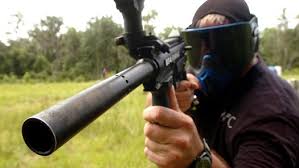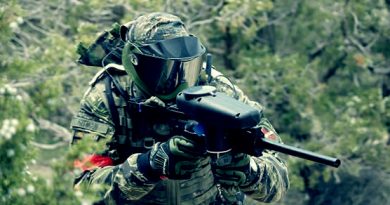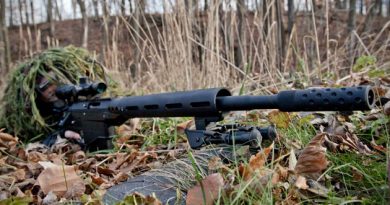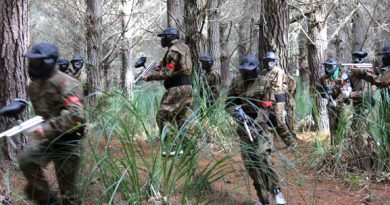Paintball aiming tips and tricks
I missed.
These are the words that are forming in your head as the other player whips around and fires three shots into your stomach, chest, and mask. The only reason he new you were there is because all of your shots flew past his head. Having trouble aiming? This guide is here to help give you some helpful hints and pointers to follow while playing, which will eventually contribute to improving your aiming and therefore your game.
One of the largest variances that I have come across while playing is the difference in positions people hold their markers with. Some hold their marker at eye level and some hold it as low as their stomach while shooting. Every position has its ups and downs, and it’s all a matter of personal preference to which you use at which time.
First on the list is the shooting from a low level, usually near the hip or stomach and sometimes closer to the chest. This position can lead to extremely inaccurate opening shots, but it can be corrected quickly by seeing where the paint flies and adjusting the aim accordingly. The primary advantage to this method is visibility; sight is not obstructed by a marker being held on one side of the player’s vision. This can make sneaking up on him or her quite hard to do if they pay attention to their peripheral vision. This aiming position is not recommended at all for speed-, air-, or x-ball, and can be very difficult to use in a close-ranged game of woodsball.
The most common position is aiming from eye level. This allows the player to see down the barrel and line up his or her shots. Some markers, like Tippmanns and power-feed markers, allow the sighting down the top of the marker, allowing a better lateral or horizontal shot. This is usually the preferred method of aiming because the first few shots are usually accurate, which means less “spraying and paying”. This method has almost the opposite advantages and disadvantages of shooting from a low level. Visibility is decreased due to a marker taking up a third or a quarter of your vision. Tunnel vision is very easy to get using this method; the player is so focused on bringing down his target that he neglects to pay attention to anything else happening on the field. This leads to very painful outcomes. This method can be employed in any format of game, ranging from airball to woodsball and beyond, and you will find most pro level players aiming like this.
However, sometimes the player may not be able to get into either of these aiming positions and shoot at the opposition, due to the opposition’s shooting at him. Snapshooting could result in a couple of paintballs to the goggles. So he’s basically useless now, right? Of course he’s not. A player can score some eliminations without even seeing the target. This method is called “blind shooting”, and can help anyone get out of a sticky situation with little effort.
What a lot of people do while blind shooting is that they hold their marker with one hand and stick it over the bunker, all the while firing wasted shots. This is wrong, and will cost a player more paint than it is worth. Even if the other team can only see the marker, that is more than enough of a target. Don’t forget, most fields call marker hits fair eliminations. If your particular field doesn’t follow that, catching a shot on the hand or arm is a definite possibility. Using this “flat shot” method of blind shooting will result in very few, if any, eliminations. This should only be used if the target is close to the player’s position and he or she knows their general lateral location.
The method that I have found works best for me is what I call the “arc shot” method. This method works best for medium- or long-range targets. The only effort involved is popping the head out for less than a second to find the target. When you look, take note of where your target is, and what is directly above him or her. After gathering this information, there is no need to expose your marker to fire at all. Keep yourself and your marker below the top of the bunker, point your barrel towards a point directly above the target, and let loose with a barrage of shots. The paint will arc down toward your target as it flies through the air. Knowing where to aim will greatly increase the chances of anyone hitting the target. Remember to estimate the distance to the target so that you can aim at the right angle as to hit it. This method works best in woodsball or any format with a similarly-sized playing area. Short-ranged shots will not have enough time to travel downward and strike the target.
There are a few more aiming variations which come into play often. A common variance is the one-handed shot. This is used often while blind shooting, using the “flat shot” method discussed above, crawling, or diving. Its main advantage is that it allows for a greater freedom of motion that allows the player to crawl, dive, or maneuver more easily while still lobbing some shots at the opposition. This is a handy position to learn and get good at, because its uses are numerous. Another common variance is attempting to shoot while running. Bunkering and run-through maneuvers are dependent on this technique. The easiest way to employ this method is to not rest the marker or tank on the shoulder, but to rather carry the marker with only the hands. This will eliminate the majority of the bumps and vibrations caused by running. Trigger speed will be affected by this, so aim carefully and squeeze off a few shots at the target. And remember, before attempting a bunkering maneuver, always find a position to run to after eliminating the target!
The last item to be discussed will improve the aim of any position that can be used. This magical technique is actually not a technique at all, but a natural characteristic of the body. It is called muscle memory, and can only be formed by practice. Muscle memory is a natural aspect of the body which causes the body to “snap” to a certain position while performing a familiar action. A prime example of this is the action of talking. Yes, talking. The mind knows that the body needs to say something, so it tells the body to move the lungs and mouth in accordance with the phrase to be spoken. The perfect synchronization of the lungs, tongue, jaw, and other parts is a product of muscle memory. The body has practiced talking so many times that it knows what to do and when, and it becomes second-nature. Practicing enough at something will result in it becoming part of muscle memory. A marker will snap towards the correct place to eliminate the target, fingers will move with a practiced and familiar motion as to maximize the rate of fire, and the target will put up his or her hand and yell “OUT!” because of experience, practice, and familiarity. Get to know your favorite technique, and use it often.
And remember, practice does not make perfect, but perfect practice does make perfect.




